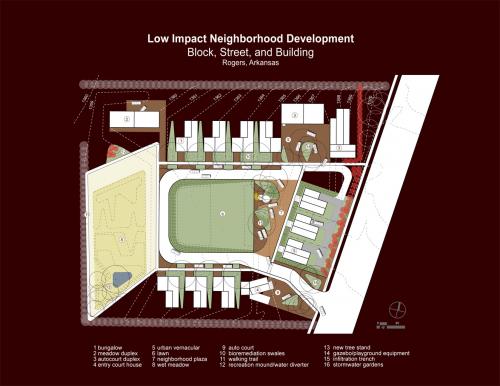
Habitat Trails. Habitat for Humanity: from infill house to green neighborhood design
Location: Rogers, AR. Suburban edge/farmland area outside of small but sprawling city
The project consists of a Low Impact Development (LID) neighborhood consisting of 17 dwelling units (avg. 1,100 sq. ft.) at $55 sq. ft. for a non-profit affordable housing provider committed to detached housing.
The development incorporates a significant range of LID technologies that preserve more than one-third of the site as commonly-held open space, enhancing ecological and urban services. Since the provider's previous approach developed one infill home at a time through volunteer labor, the project's goals are to: 1) establish a repeatable model for affordable neighborhood development that solves for economic, environmental, and social metrics, 2) inflect local municipal codes to allow for LID technologies, including ecological-based stormwater management, and 3) offer high-value residential solutions to underserved populations and their surrounding communities.
Parks, Not Pipes
Low Impact Development
The neighborhood is developed in accord with the site's existing hydrological drainage, catchment, and recharge patterns. Stormwater runoff from new development is treated through a system of bioswale corridors, infiltration trenches, stormwater gardens, sediment filter strips, "green streets" and a constructed wet meadow. The integration of a constructed treatment landscape with open space sustitutes an ecological-based stormwater management system for the expensive curb-gutter-pipe solution in civil infrastructure. Rather than costing $450/linear foot, street infrastructure costs $250/linear foot while enhancing pedestrian facilities.
Green Streets
Integrating Ecological and Urban Services
Streets are designed as landscapes to calm vehicular traffic and provide ecological-based stormwater management. LID solutions treat runoff in-situ at half the cost of curb-gutter-pipe systems and instead improve local groundwater quality. "Skinny streets" surfaced with pervious grasscrete parking strips, rain gardens, and granulated stone parking courts minimize costly, impervious pavement while dampening motorist speeds. Ecological services related to improved water quality, dissipation of peak flows to prevent flooding, erosion, sediment transport control, and habitat and meadow restoration are enhanced while avoiding the systemic failures common in civil infrastructure. Collateral urban services include enhanced neighborhood aesthetics and pedestrian-oriented environments, additional passive recreation assets, and greater urban biodiversity. Contrary to civil "pipe and pond" solutions, the street is an integral landscape component in a larger watershed solution.
Porches
The Green Neighborhood Transect
A "living transect" consisting of public and private ecotones with the porch as a hinge component ensures that house typologies are developed in tandem with neighborhood landscapes. Stormwater bioswale corridors replace the individual green lawn, visually linking porch and street. Raised porches extend the home's modest internal living space and function as breezeways to promote convective ventilation through home interiors. These neighborhood ecotones serve as context-producing strategies for achieving quality within affordable parameters.
Lessons learned: 1) LID solutions are superior to conventional civil "pipe and pond" solutions based on economic, environmental, and aesthetic criteria, 2) Technical solutions in Greet Streets require parallel political solutions as skinny streets, alternative runoff treatment strategies, and impervious surface materials are against most municipal codes, 3) Single-loaded streets can be efficient, 4) Everybody, including the bottom-line oriented skeptic, loves a well-designed porch.
Transect Zone(s): T2 reserve, T3 sub-urban.
Status: 1-25% Built
Project or Plan's Scale: Block
Features: Affordable/subsidized housing, Civic buildings & parks, Green buildings, Sustainable infrastructure.
Land area (in acres): 5
Total built area (in sq. ft.):
Retail area (in sq. ft.):
Office area (in sq. ft.):
Industrial area (in sq. ft.):
Number of hotel units:
Number of residential units (include live/work): 17
Civic uses (type and size): neighborhood pocket park
Parks & green space (in acres): 1
Project team designers: University of Arkansas Community Design Center
Project team developers: Habitat for Humanity of Benton County, Inc.
Previous site status: Undeveloped greenfield




